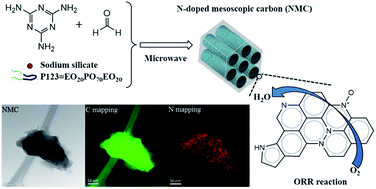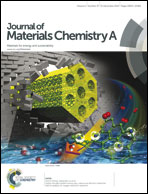Highly nitrogen-doped mesoscopic carbons as efficient metal-free electrocatalysts for oxygen reduction reactions†
Abstract
A facile method was developed for the synthesis of metal-free, highly N-doped (>7 wt%) mesoscopic carbons (NMCs), which were fabricated by first preparing carbon–silicate (C–Si) composites by co-condensation method using a melamine-formaldehyde resin oligomer as the primary nitrogen and carbon source, and P123 triblock copolymer surfactant and sodium silicate as the soft and hard template, respectively, under microwave irradiation conditions, followed by carbonization and silica-template removal. The NMCs were found to exhibit superior electrocatalytic activity, long-term stability, and excellent tolerance over methanol crossover effect. Such NMCs derived from organic–inorganic hybrids assisted by microwave heating not only possess high surface areas and active quaternary and pyridinic-N species that are favourable for ORR, as verified by DFT calculations, but also render large-scale production and practical applications as cost-effective electrode materials.

- This article is part of the themed collection: 2014 Journal of Materials Chemistry A Hot Articles


 Please wait while we load your content...
Please wait while we load your content...